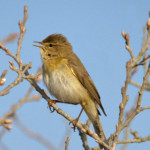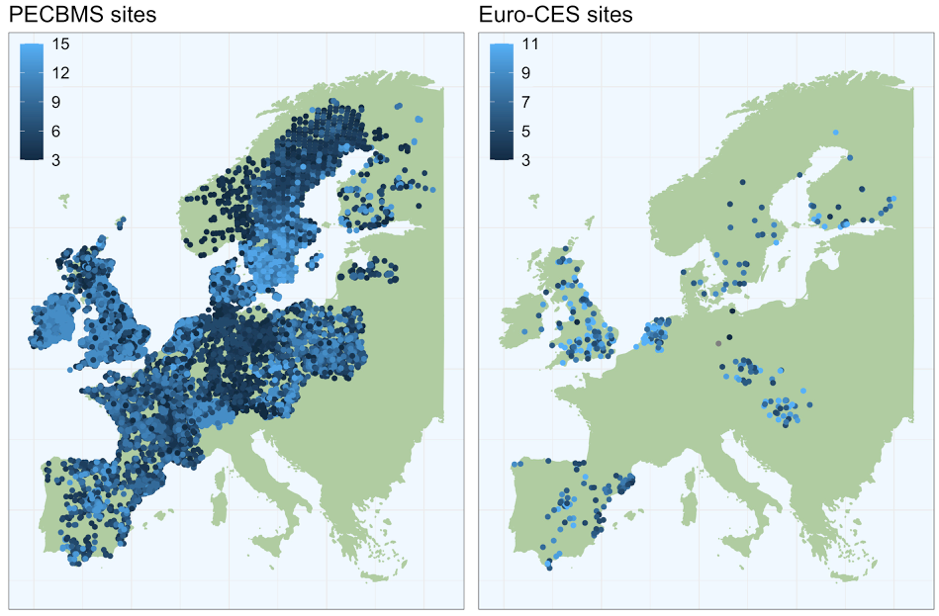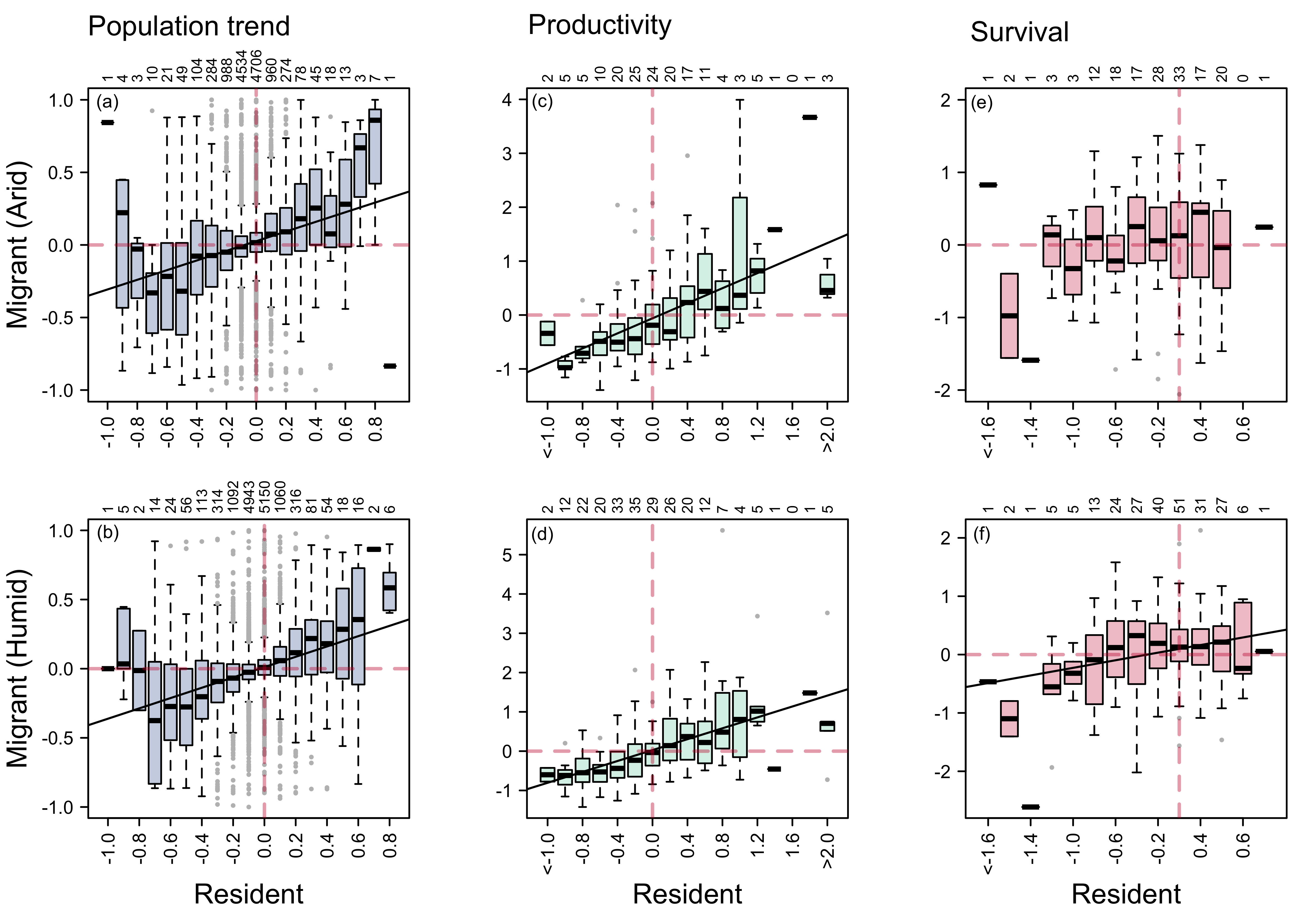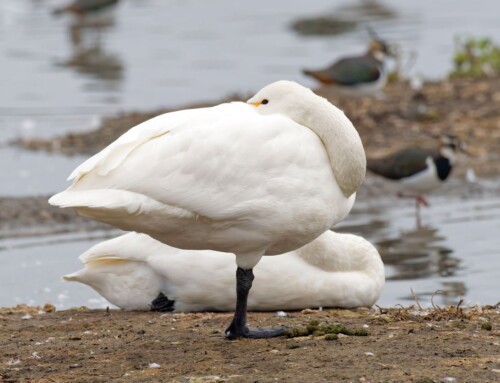LINKED PAPER
Covariation in population trends and demography reveals targets for conservation action. Morrison, C.A., Butler, S.J., Robinson, R.A., Clark, J.A., Arizaga, J., Aunins, A., Baltà, O., Cepák, J., Chodkiewicz, T., Escandell, V., Foppen, R.P.B., Gregory, R.D., Husby, M., Jiguet, F., Kålås, J.A., Lehikoinen, A., Lindström, A., Moshøj, C.M., Nagy, K., Nebot, A.L., Piha, M., Reif, J., Sattler, T., Škorpilová, J., Szép, T., Teufelbauer, N., Thorup, K., van Turnhout, C., Wenninger, T. & Gill, J.A. 2021 Proceedings of the Royal Society B: Biological Sciences. DOI: rspb.2020.2955 VIEW
 Across Europe, severe population declines are currently occurring in many African-Eurasian bird species. While the causes of these declines are not yet fully understood, the impact is greatest on species overwintering in the humid-zone, in countries such as the Ivory Coast and Ghana. Interestingly, species that travel to the Sahel zone (known as arid-zone migrants), just south of the Sahara Desert, are generally not declining at present. Correctly targeting conservation actions to help reverse population declines is not an easy task. There are many environmental changes that could be contributing to population declines in humid-zone species. These include habitat loss on the African non-breeding grounds, climatic effects on timing of migration and breeding, to changing agricultural practices degrading the quality and availability of breeding sites. A further hurdle in our understanding of migratory systems is that we are only just starting to discover the variation in individual migratory journeys, revealing great differences in timings and routes. For example, tracking studies are now repeatedly showing that individuals that nest within the same patch of habitat in Europe can spend the non-breeding season separated by thousands of kilometres.
Across Europe, severe population declines are currently occurring in many African-Eurasian bird species. While the causes of these declines are not yet fully understood, the impact is greatest on species overwintering in the humid-zone, in countries such as the Ivory Coast and Ghana. Interestingly, species that travel to the Sahel zone (known as arid-zone migrants), just south of the Sahara Desert, are generally not declining at present. Correctly targeting conservation actions to help reverse population declines is not an easy task. There are many environmental changes that could be contributing to population declines in humid-zone species. These include habitat loss on the African non-breeding grounds, climatic effects on timing of migration and breeding, to changing agricultural practices degrading the quality and availability of breeding sites. A further hurdle in our understanding of migratory systems is that we are only just starting to discover the variation in individual migratory journeys, revealing great differences in timings and routes. For example, tracking studies are now repeatedly showing that individuals that nest within the same patch of habitat in Europe can spend the non-breeding season separated by thousands of kilometres.
During my PhD, we explored the possible drivers of population declines, in one humid-zone species, the Willow Warbler. Interestingly we found that while numbers have declined in England, they have remained stable or in some cases increased in Scotland. A further dive into the data showed this pattern was common among many migrant and, importantly, resident species. Something was going wrong on the English breeding grounds that wasn’t happening in Scotland, and it wasn’t just affecting migrant species. Using population modelling we showed that, for willow warblers, a couple of years of high mortality, at the start of the 2000s, caused sharp population declines in both Scotland and England. However, after that time, survival rates subsequently recovered in both countries and, in Scotland, these years of good survival were also years in which productivity was high, allowing the population to recover, relatively quickly, within a decade. In England, however, productivity was not high enough in England to allow a similar recovery, and so numbers have stayed low. You can read more about this study in a previous BOU blog.
These regional-scale differences suggest that breeding season conditions are influencing migrant population trends. It seems that having productivity that is sufficiently high, across a sufficiently large number of sites may be key to allowing populations to recover from periods when mortality is high. However, to be more certain that this is the case, we need to know whether the residents and migrants breeding on the same sites show similar population trends. This could help us to understand where conservation actions should be targeted; if sites are consistently ‘good’ or ‘poor’ for whole bird communities, then we could potentially target conservation actions to boost productivity at ‘poor’ sites to hopefully influence population trends.
For decades now, across much of the European breeding grounds, standardised annual counts and captures of breeding birds have been carried out by a dedicated network of volunteer ornithologists and bird ringers. Surveys of numbers of breeding birds are collated by the Pan-European Common Bird Survey (PECBMS), while variation in productivity and survival rates can be calculated from the ringing data held by the European Constant Effort Sites Scheme (Euro-CES) (Figure 1).
 Figure 1 The location of PECBMS sites and Euro-CE sites in Europe, colours indicate the number of years sites were active for during the study period (PECBMS: 1994 to 2013 & Euro-CES: 2004 to 2014).
Figure 1 The location of PECBMS sites and Euro-CE sites in Europe, colours indicate the number of years sites were active for during the study period (PECBMS: 1994 to 2013 & Euro-CES: 2004 to 2014).
Using data from 13859 PECBMS sites over the last two decades, we showed that migrants (from both arid and humid zones) and residents in the same sites tend to be showing the same populations trends (increasing or decreasing; Figure 2a,b). We then used ringing data from 336 European Constant Effort Sites (Euro-CES) to show that productivity (numbers of young caught per adult) also varies consistently between sites. For both resident and migrants, there are ‘good’ sites which consistently produce lots of young, and ‘poor’ sites which consistently produce few young (Figure 2c,d). We also used Euro-CES data to measure annual survival rates but found no such patterns (Figure 2e,f). This suggests that targeting conservation actions at survival rates within Europe is likely to prove extremely challenging, as mortality can occur at any point in the year, and mortality rates can vary greatly within and between species breeding at the same sites. However, targeting actions in sites with consistently low productivity does appear to be potentially feasible.
 Figure 2 Covariation between resident bird species and their co-occurring arid-zone (top row) and humid-zone (bottom row) migrant species in mean site-level (a,b) population trends (a: 12,103 sites; b: 13,267 sites), (c,d) standardised mean site-level productivity (c: 156 sites; d: 247 sites) and (e,f) standardised mean site-level annual survival rates (e: 156 sites; f: 247 sites). Lines of best fit are shown for significant associations and numbers indicate the number of sites. Horizontal bars indicate medians, boxes indicate interquartile range, whiskers indicate minimum and maximum values and circles indicate values 1.5 times higher or lower than 1st and 3rd interquartile, respectively. From Morrison et al. 2021.
Figure 2 Covariation between resident bird species and their co-occurring arid-zone (top row) and humid-zone (bottom row) migrant species in mean site-level (a,b) population trends (a: 12,103 sites; b: 13,267 sites), (c,d) standardised mean site-level productivity (c: 156 sites; d: 247 sites) and (e,f) standardised mean site-level annual survival rates (e: 156 sites; f: 247 sites). Lines of best fit are shown for significant associations and numbers indicate the number of sites. Horizontal bars indicate medians, boxes indicate interquartile range, whiskers indicate minimum and maximum values and circles indicate values 1.5 times higher or lower than 1st and 3rd interquartile, respectively. From Morrison et al. 2021.
Our results show that there will likely be actions we can target at improving conditions on breeding sites across Europe, which will benefit migrant populations. Our next steps are to try to identify how conditions differ between ‘good’ and ‘poor’ sites, and the types of conservation actions that might be needed to increase the frequency of ‘good’ sites. This has the potential to benefit migrant and resident species alike.
References
Vickery, J.A., Ewing, S.R., Smith, K.W., Pain, D.J., Bairlein, F., Škorpilová, J. & Gregory, R.D. 2014. The decline of Afro‐Palaearctic migrants and an assessment of potential causes. IBIS 156:1-22.VIEW
Finch, T., Butler, S.J., Franco, A.M. & Cresswell, W. 2017. Low migratory connectivity is common in long‐distance migrant birds. Journal of Animal Ecology 86: 662-673. VIEW
Morrison, C.A., Robinson, R.A., Clark, J.A. & Gill, J.A. 2010. Spatial and temporal variation in population trends in a long‐distance migratory bird. Diversity and Distributions 16: 620-627. VIEW
Morrison, C.A., Robinson, R.A., Clark, J.A., Risely, K. & Gill, J.A. 2013. Recent population declines in Afro‐Palaearctic migratory birds: the influence of breeding and non‐breeding seasons. Diversity and Distributions 19:1051-1058. VIEW
Morrison, C.A., Robinson, R.A., Butler, S.J., Clark, J.A. & Gill, J.A. 2016. Demographic drivers of decline and recovery in an Afro-Palaearctic migratory bird population. Proceedings of the Royal Society B: Biological Sciences 283:20161387. VIEW
Image credit
Top right: Willow Warbler Phylloscopus trochilus, Andreas Trepte, CC BY-SA 2.5, Wikimedia Commons





